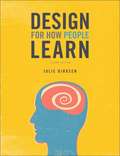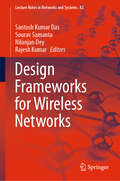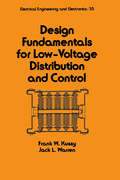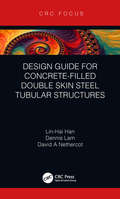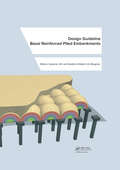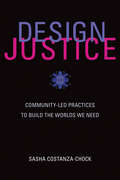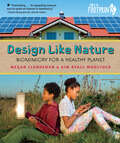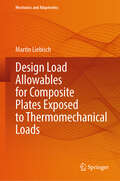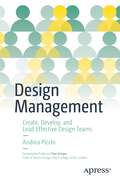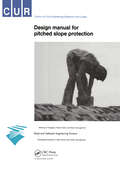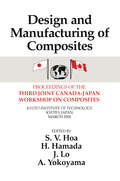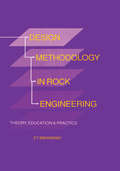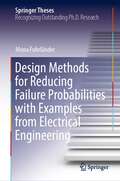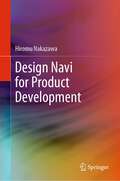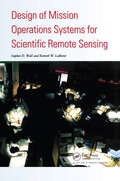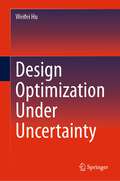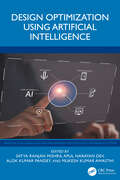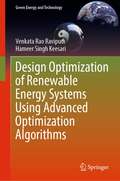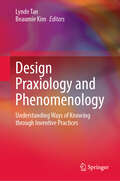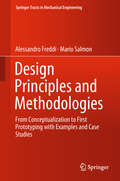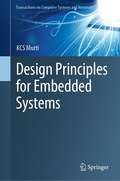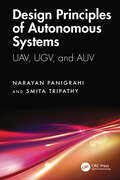- Table View
- List View
Design For How People Learn (Voices That Matter)
by Julie DirksenIn this book, you will discover how to use the key principles behind learning, memory, and attention to create materials that enable your audience to both gain and retain the knowledge and skills you're sharing. Updated to cover new insights and research into how we learn and remember, this new edition includes new techniques for using social media for learning as well as two brand new chapters on designing for habit and best practices for evaluating learning, such as how and when to use tests. Using accessible visual metaphors and concrete methods and examples, this book will teach you how to leverage the fundamental concepts of instructional design both to improve your own learning and to engage your audience.
Design Frameworks for Wireless Networks (Lecture Notes in Networks and Systems #82)
by Nilanjan Dey Rajesh Kumar Santosh Kumar Das Sourav SamantaThis book provides an overview of the current state of the art in wireless networks around the globe, focusing on utilizing the latest artificial intelligence and soft computing techniques to provide design frameworks for wireless networks. These techniques play a vital role in developing a more robust algorithm suitable for the dynamic and heterogeneous environment, making the network self-managed, self-operational, and self-configurational, and efficiently reducing uncertainties and imprecise information.
Design Fundamentals for Low-Voltage Distribution and Control
by Frank KussyDesign Fundamentals for Low-Voltage Distribution and Control provides practical guidelinesfor all aspects of this vital topic. Linking theoretical principles with real hardware designs,the book will help engineers meet safety and regulatory standards, reduce redesign costs,shorten product development and testing cycles, and develop more reliable, efficientequipment.This outstanding reference highlights the determination of reactance and resistances of conductors... discusses heat transfer problems in industrial apparatus . .. and considers shortcircuit and ground fault calculations as well as temperature rise and forces occurring underfault conditions.Design Fundamentals for Low-Voltage Distribution and Control applies thermodynamicprinciples to electrical equipment, including coverage of heat transfer equations, calculationexamples for conductor sizes, and insulation. It provides empirical models to show howhigher order theoretical equations can be practically approximated . . . and includes samplecalculations for magnet size, circuit breakers, fault current, arc interruption, and other propertiesand equipment.In addition, the book compares design requirements for both U.S. and European equipment.Featuring numerous equations, graphs, tables, test procedures, and diagrams, Design Fundamentalsfor Low-Voltage Distribution and Control is an invaluable practical guide for electricaland electronics, design, project, and power engineers involved with the design andapplication of electrical apparatus; and graduate students of electrical engineering, powerengineering, and electro technology.
Design Guide for Concrete-filled Double Skin Steel Tubular Structures
by David Nethercot Dennis Lam Lin-Hai HanThis is the first design guide on concrete filled double skin steel tubular (CFDST) structures. It addresses in particular CFDST structures with plain concrete sandwiched between circular hollow sections, and provides the relevant calculation methods and construction provisions for CFDST structures. <P><P>These inherit the advantages of conventional concrete-filled steel tubular (CFST) structures, including high strength, good ductility and durability, high fire resistance and favourable constructability. Moreover, because of their unique sectional configuration, CFDST structures have been proved to possess lighter weight, higher bending stiffness and better cyclic performance than conventional CFST. Consequently CFDST can offer reduced concrete consumption and construction costs. <P><P>This design guide is for engineers designing electrical grid infrastructures, wind power towers, bridge piers and other structures requiring light self-weight, high bending stiffness and high bearing capacity.
Design Guideline Basal Reinforced Piled Embankments
by Suzanne J.M. van Eekelen; Marijn H.A. BrugmanA basal reinforced piled embankment consists of a reinforced embankment on a pile foundation. The reinforcement consists of one or more horizontal layers of geosynthetic reinforcement installed at the base of the embankment.A basal reinforced piled embankment can be used for the construction of a road or a railway when a traditional construction method would require too much construction time, affect vulnerable objects nearby or give too much residual settlement, making frequent maintenance necessary.This publication is a guideline (CUR226) for the design of basal reinforced piled embankments. The guideline covers the following subjects: a survey of the requirements and the basic principles for the structure as a whole; some instructions for the pile foundation and the pile caps; design rules for the embankment with the basal geosynthetic reinforcement; extensive calculation examples; finite element calculations; construction details and management and maintenance of the piled embankment. The guideline includes many practical tips. The design guideline is based on state-of-the-art Dutch research, which was conducted in cooperation with many researchers from different countries.
Design Justice: Community-Led Practices to Build the Worlds We Need (Information Policy)
by Sasha Costanza-ChockAn exploration of how design might be led by marginalized communities, dismantle structural inequality, and advance collective liberation and ecological survival.What is the relationship between design, power, and social justice? “Design justice” is an approach to design that is led by marginalized communities and that aims expilcitly to challenge, rather than reproduce, structural inequalities. It has emerged from a growing community of designers in various fields who work closely with social movements and community-based organizations around the world.This book explores the theory and practice of design justice, demonstrates how universalist design principles and practices erase certain groups of people—specifically, those who are intersectionally disadvantaged or multiply burdened under the matrix of domination (white supremacist heteropatriarchy, ableism, capitalism, and settler colonialism)—and invites readers to “build a better world, a world where many worlds fit; linked worlds of collective liberation and ecological sustainability.” Along the way, the book documents a multitude of real-world community-led design practices, each grounded in a particular social movement. Design Justice goes beyond recent calls for design for good, user-centered design, and employment diversity in the technology and design professions; it connects design to larger struggles for collective liberation and ecological survival.
Design Like Nature: Biomimicry for a Healthy Planet (Orca Footprints #20)
by Megan Clendenan Kim Ryall Woolcock★“Fascinating…An appealing resource sure to spark an interest in biomimicry, from casual readers to budding scientists. Recommended for all libraries.”—School Library Journal, starred review Did you know that lamps can be powered by glowing bacteria instead of electricity? That gloves designed like gecko feet let people climb straight up glass walls? Or that kids are finding ways to make compostable plastic out of banana peels? Biomimicry, the scientific term for when we learn from and copy nature, is a revolutionary way to look to nature for answers to environmental problems such as climate change. In Design Like Nature young readers discover innovations and inventions inspired by the environment. Nature runs the entire planet with no waste and no pollution. Can humans learn to do this too? It's time to step outside and start designing like nature.
Design Load Allowables for Composite Plates Exposed to Thermomechanical Loads (Mechanics and Adaptronics)
by Martin LiebischCurrent methodologies used to design lightweight structures made of CFRP materials under static thermomechanical conditions often rely on simplified approaches. In particular, the temperature-related design case is typically described by assuming a uniform distribution of the worst-case temperature, which is the maximum allowable temperature that can occur simultaneously with the mechanical loads. However, these simplifications can lead to a weight penalty due to their over-conservatism. To address these limitations, the present work describes a novel analysis methodology that accounts for spatial distributions of temperature. This approach allows for a more detailed understanding of the structural behavior under these demanding conditions. As a result, existing load-carrying potentials can be identified and used to fully exploit the advantage of CFRP structures. Moreover, this methodology generates an improved understanding of the variability in the structural behavior under such scattering thermal conditions, which can increase confidence and reliability in the design process and lead to reduce related margins of safety. To accurately model the mechanical behavior of structures at distributed temperature conditions, it is essential to consider the temperature-dependent properties of the material. These properties describing the elastic and strength behavior of the unidirectional ply, are derived from typical material characterization performed at various temperatures. In this approach, a phenomenological model is used to account for the temperature dependence of the material. This model is fitted to the characterization results to consider the individual magnitude of the properties. The resulting property allowables contain typical material uncertainties, as well as the model uncertainty that is defined by assessing the errors between the model and measurement. To determine the stability and strength behavior of structures under different thermal conditions, Finite-Element-Analysis (FEA) is utilized. Variations of thermal load distributions are analyzed to consider the uncertainty in opertational conditions qualitatively and quantitatively. A series of such analyses is conducted at different thermal conditions to determine design values such as buckling loads or failure loads. Based on this data, surrogate modeling leads to design value formulation as a function of the temperature distribution. This approach provides a more comprehensive and reliable assessment of the structural behavior under different thermal conditions and enables to either determine more realistic worst-case behavior or enhanced design values such as probabilistic structural allowables. The final part of the thesis demonstrates the developed analysis methodology on representative skin field structures. The comparison to the common analysis procedure highlights the potentials of structural load carrying capability and reveals deficiencies in the present approach. Thus, a detailed modelling of the temperature distribution leads additionally to an improved reliability of the design process and more efficient and robust structures.
Design Management: Create, Develop, and Lead Effective Design Teams
by Andrea PicchiDesigners are more in-demand than ever, and companies all over the world are creating new leadership roles to manage them. With only a few select institutions teaching effective design management skills, self-taught design managers are on the rise and resources are needed to guide them. This book will help you hone your leadership skills and magnify your team’s potential. Eager designers will learn the behavioral abilities required to lead and manage impactful and efficient teams using a systemic, context-agnostic, and therefore repeatable approach. While effective design management is vital in these times of complexity and fast change in organizations, the available literature on design management is insufficient, predominately informative, and unfortunately, not actionable. This book fills that gap by illuminating the soft skills you need to lead your team to success. You'll gain confidence about how to optimize meetings, run successful kickoffs, manage yourself, and how to best approach and frame your working environment. Whether you are a designer looking to lead, or a member of an organization looking for guidance on how to better incorporate design, this book belongs on your shelf. Design Management is here to assist you in the long haul.What You'll LearnComprehend the underlying social and psychological dynamics of leadership and managementCultivate the behavioral elements of a design managerUnderstand the building blocks of a design leaderEstablish your core practices and create a self-development programDevelop and project healthy and sustainable influenceBuild trust, create psychological safety, and fulfill the social needs of high-performing teamsCoach individuals and groups to unlock creativity and nurture creative collaborationOptimize in-person and remote design operations Who This Book Is ForEveryone who desires to expand and deepen their knowledge of design leadership and management, comprehending the social and psychological underpinning elements of this discipline. Aspiring or recently appointed design leaders and managers who necessitate a practical education in this field and individuals already in charge of a group who aspire to evolve their understanding to advance their career toward a Head of Design or Chief Design Officer role.
Design Management: The Essential Handbook
by David HandsDesign Management is a discipline in continual motion - changing, responding and adapting to the ever increasing dynamics of social and business transformation. The value of design has grown monumentally since its embryonic stages in the late 1970s, and it now reaches far beyond the realm of industry and commerce, forging a strong presence within the public sector institutions and not-for-profit organisations. Design Management is, quite simply, the essential handbook to all things design. Highly international in its approach, the text is structured around four key perspectives - values, horizons, visions and futures. Each individual section is complemented by input from contributors, with industry leaders and policy makers offering real-world commentary. Ultimately, Design Management represents an important and timely contribution to the discipline of design management itself, and correspondingly the development of product and service innovation. The book argues that design management is a key asset in organisational activity throughout a wide and diverse variety of industrial and geographic contexts within an increasingly globalized world. Engaging and accessible in style, Design Management offers students and practitioners everything they need to know to foster a climate of creative engagement.
Design Manual for Pitched Slope Protection: CUR-Reports 155
by Gouda CurThis manual describes current methods for designing dike revetments of pitched blocks and block mattresses. The use of such revetments on river canal banks is also considered briefly. Guidelines are discussed for preparing designs for new revetments; Methods are also given for checking existing revetments. The manual is aimed at the practical application of the result of basic research into block pitching. Pitched dike revetments include following revetments systems: Basalt and other natural rock; Concrete blocks, column and other small cement concrete elements and Block mattresses.
Design Manufacturing Composites, Third International Canada-Japan Workshop
by Suong V. HoaThis book contains technical papers, presented at the third joint Canada-Japan workshop on Composites held in Japan in 2000, on topics, including smart composites, composites in civil construction, toughened composites, textile composites, braided composites, and thermoplastic composites.
Design Methodology for Future Products: Data Driven, Agile and Flexible
by Dieter Krause Emil HeydenDesign Methodology for Future Products – Data Driven, Agile and Flexible provides an overview of the recent research in the field of design methodology from the point of view of the members of the scientific society for product development (WiGeP - Wissenschaftliche Gesellschaft für Produktenwicklung e.V.). This book aims to contribute to design methods and their implementation for innovative future products. The main focus is the crucial data-driven, agile, and flexible way of working.Four topics are covered in corresponding chapters, Methods for Product Development and Management, Methods for Specific Products and Systems, Facing the Challenges in Product Development and Model-Based Engineering in Product Development. This publication starts with the agile strategic foresight of sustainable mechatronic and cyber-physical systems, moves on to the topics of system generation engineering in development processes, followed by the technical inheritance in data-driven product development. Product improvements are shown via agile experiential learning based on reverse engineering and via combination of usability and emotions. Furthermore, the development of future-oriented products in the field of biomechatronic systems, sustainable mobility systems and in situ sensor integration is shown. The overcoming of challenges in product development is demonstrated through context-adapted methods by focusing on efficiency and effectiveness, as well as designer-centered methods to tackle cognitive bias. Flow design for target-oriented availability of data and information in product development is addressed. Topics of model-based systems engineering are applied to the function-driven product development by linking model elements at all stages and phases of the product. The potential of model-based systems engineering for modular product families and engineering of multidisciplinary complex systems is shown.
Design Methodology in Rock Engineering
by Z.T. BieniawskiThe first comprehensive treatment of the subject of design methodology in rock engineering, this book emphasizes that a good designer needs not only knowledge for designing (technical knowledge) but also must have knowledge about designing (an appropriate process to follow). Design methodology is today recognized in most fields as crucial to the success of a new product, process, or construction project.This unique book starts with an appraisal of current trends concerning global design activities and competitiveness and gives an insight into how designers design. The state of the art in engineering design is given with a detailed exposé of all significant design theories and methodologies. It then presents a design methodology specifically for rock engineering and demonstrates its practical use on the basis of important case histories. To preserve the momentum of the design message, design education is also discussed. A separate chapter is devoted to skills development, presenting the designer with an extensive repertoire of widely available tools and concepts. The Appendix lists a compendium of useful design charts for rock engineering, traced after a thorough literature search. A Bibliography concludes the book with an up-to-date list of references.
Design Methods for Reducing Failure Probabilities with Examples from Electrical Engineering (Springer Theses)
by Mona FuhrländerThis book deals with efficient estimation and optimization methods to improve the design of electrotechnical devices under uncertainty. Uncertainties caused by manufacturing imperfections, natural material variations, or unpredictable environmental influences, may lead, in turn, to deviations in operation. This book describes two novel methods for yield (or failure probability) estimation. Both are hybrid methods that combine the accuracy of Monte Carlo with the efficiency of surrogate models. The SC-Hybrid approach uses stochastic collocation and adjoint error indicators. The non-intrusive GPR-Hybrid approach consists of a Gaussian process regression that allows surrogate model updates on the fly. Furthermore, the book proposes an adaptive Newton-Monte-Carlo (Newton-MC) method for efficient yield optimization. In turn, to solve optimization problems with mixed gradient information, two novel Hermite-type optimization methods are described. All the proposed methods have been numerically evaluated on two benchmark problems, such as a rectangular waveguide and a permanent magnet synchronous machine. Results showed that the new methods can significantly reduce the computational effort of yield estimation, and of single- and multi-objective yield optimization under uncertainty. All in all, this book presents novel strategies for quantification of uncertainty and optimization under uncertainty, with practical details to improve the design of electrotechnical devices, yet the methods can be used for any design process affected by uncertainties.
Design Navi for Product Development
by Hiromu NakazawaThis book delves into Feasibility Prediction Theory (FPT) and its real-world application in product development. Organized into four p arts, it covers essential feasibility prediction concepts, explores project feasibility studies, delves into Design Navi for product design realization, and guides readers in adopting a successful mindset for product development. With practical insights and examples, this guide serves as an indispensable resource for those engaged in product development endeavors.
Design Of Mission Operations Systems For Scientific Remote Sensing
by S D Wall K W LedbetterA definitive description of the various models of mission operations systems MOS which provides an account of the design process and of the general principles of the designs themselves. The principles described can be applied to all types of scientific remote sensing.
Design Optimization Under Uncertainty
by Weifei HuThis book introduces the fundamentals of probability, statistical, and reliability concepts, the classical methods of uncertainty quantification and analytical reliability analysis, and the state-of-the-art approaches of design optimization under uncertainty (e.g., reliability-based design optimization and robust design optimization). The topics include basic concepts of probability and distributions, uncertainty quantification using probabilistic methods, classical reliability analysis methods, time-variant reliability analysis methods, fundamentals of deterministic design optimization, reliability-based design optimization, robust design optimization, other methods of design optimization under uncertainty, and engineering applications of design optimization under uncertainty.
Design Optimization Using Artificial Intelligence (Artificial Intelligence and Machine Learning for Intelligent Engineering Systems)
by Mukesh Kumar Awasthi Alok Kumar Pandey Satya Ranjan Mishra Apul Narayan DevDesign Optimization Using Artificial Intelligence serves as an insightful resource for understanding the transformative role of Artificial Intelligence (AI) in optimizing design processes across a variety of fields. This book explores foundational concepts, advanced methodologies, and real-world applications, offering a comprehensive guide to leveraging AI for innovative design solutions.Covering a broad spectrum of topics, the book examines algorithmic advancements, machine learning techniques, and optimization strategies that enhance design efficiency and accuracy. It delves into AI's applications in sustainable energy systems, biomedical innovations, image processing, cyber-security, and other critical domains, showcasing its ability to solve complex challenges with precision and creativity.The content bridges theoretical foundations with practical implementations, incorporating case studies that highlight successful applications of AI-driven design optimization. Readers will gain valuable insights into state-of-the-art tools, programming techniques, and frameworks that drive advancements in intelligent design systems.Features: Explores AI-driven methodologies for enhancing design accuracy and efficiency Discusses advanced machine learning techniques and optimization algorithms Highlights AI's applications in diverse fields such as energy systems, healthcare, image processing, and cyber-security Includes in-depth case studies to illustrate real-world implementations of AI in design optimization Investigates future trends and the potential of AI to transform traditional design processes Targeted at researchers, engineers, and students in the fields of artificial intelligence, computational science, and engineering, this book is an essential reference for anyone seeking to understand and utilize AI in the realm of design optimization. It provides the tools and knowledge necessary to harness AI's power for innovative, efficient, and intelligent design solutions.
Design Optimization of Renewable Energy Systems Using Advanced Optimization Algorithms (Green Energy and Technology)
by Venkata Rao Ravipudi Hameer Singh KeesariThis book describes applications of Jaya and Rao algorithms on real case studies concerning different renewable energy sources.In the last few decades, researchers have focused on renewable energy resources like solar energy, bio-energy, wave energy, ocean thermal energy, tidal energy, geothermal energy, and wind energy. This has resulted in the development of new techniques and tools that could harvest energy from renewable energy sources. Many researchers and scientists have focused on developing and optimizing the energy systems to extract and utilize renewable energy more efficiently.In this book, recently developed Jaya and Rao (Rao-1, Rao-2, and Rao-3) algorithms are introduced for single- and multi-objective optimization of selected renewable energy systems. The results of applications of the different versions of Jaya and Rao algorithms are compared with the other optimization techniques like GA, NSGA-II, PSO, MOPSO, ABC, etc., and the performance of the Jaya and Rao algorithms is highlighted compared to other optimization algorithms in the case of renewable energy systems.The book also includes the validation of different versions of the Jaya and Rao algorithms through the application to complex single- and multi-objective unconstrained benchmark functions. The algorithms and computer codes of different version of Jaya and Rao algorithms are included in the book that will be very much useful to readers in industry and academic research.
Design Paradigms
by Henry PetroskiFrom classical temples to twentieth century towers, engineers have learned more about design from failure than from success. The concept of error, according to the author of Design Paradigms, is central to the design process. As a way of explaining the enduring aspects of engineering design, Henry Petroski relates stories of some of the greatest engineering successes and failures of all time. These case studies, drawn from a wide range of times and places, from Ancient Greece and Rome to modern America, serve as paradigms of error and judgment in engineering design. By showing how errors were introduced in the design process and how they might be avoided, the book suggests how better quality and reliability might be achieved in designed devices, structures, and systems of all kinds. Clearly written, with striking illustrations, the book will appeal to engineering students, practicing engineers, historians of science and technology, and all those interested in learning about the process of design.
Design Praxiology and Phenomenology: Understanding Ways of Knowing through Inventive Practices
by Beaumie Kim Lynde TanThis book offers insight into designerly ways of knowing from the perspectives of experts and professionals engaging in diverse forms of design in workplaces and other public domains. It also aids in the understanding of design practices from designers’ viewpoints via case studies. By pursuing a reflective inquiry in their design epistemology (designerly ways of knowing), design praxiology (practices of design), or design phenomenology (forms of designs), self-studies of design practices, and presenting studies of designs, the authors of this book demonstrate how they influence the people and the object of inquiry or design. The case studies presented in this book also illustrate how designers develop their expertise, and provides inspiration for the incorporation of design-thinking and practice in education.
Design Principles and Methodologies: From Conceptualization to First Prototyping with Examples and Case Studies (Springer Tracts in Mechanical Engineering)
by Alessandro Freddi Mario SalmonThis book introduces readers to the core principles and methodologies of product development, and highlights the interactions between engineering design and industrial design. It shows to what extent the two cultures can be reconciled, and conversely what makes each of them unique. Although the semantic aspect is fundamental in industrial design, while the functional aspect is essential for the industrial product, the interaction between the two worlds is strategically vital. Design is also a strategic problem-solving process that drives innovation, builds business success and leads to better quality of life through innovative products, systems, services and experiences. The book connects product development with the concepts and strategies of innovation, recognizing that product design is a complex process in which invention, consumers’ role, industrial technologies, economics and the social sciences converge. After presenting several examples of artifacts developed up to the conceptual phase or built as prototypes, the book provides a case study on a packaging machine, showcasing the principles that should underlie all design activities, and the methods that must be employed to successfully establish a design process. The book is primarily targeted at professionals in the industry, design engineers and industrial designers, as well as researchers and students in design schools, though it will also benefit any reader interested in product design.
Design Principles for Embedded Systems (Transactions on Computer Systems and Networks)
by KCS MurtiThe book is designed to serve as a textbook for courses offered to graduate and undergraduate students enrolled in electronics and electrical engineering and computer science. This book attempts to bridge the gap between electronics and computer science students, providing complementary knowledge that is essential for designing an embedded system. The book covers key concepts tailored for embedded system design in one place. The topics covered in this book are models and architectures, Executable Specific Languages – SystemC, Unified Modeling Language, real-time systems, real-time operating systems, networked embedded systems, Embedded Processor architectures, and platforms that are secured and energy-efficient. A major segment of embedded systems needs hard real-time requirements. This textbook includes real-time concepts including algorithms and real-time operating system standards like POSIX threads. Embedded systems are mostly distributed and networked for deterministic responses. The book covers how to design networked embedded systems with appropriate protocols for real-time requirements. Each chapter contains 2-3 solved case studies and 10 real-world problems as exercises to provide detailed coverage and essential pedagogical tools that make this an ideal textbook for students enrolled in electrical and electronics engineering and computer science programs.
Design Principles of Autonomous Systems: UAV, UGV, and AUV
by Narayan Panigrahi Smita TripathyThis book explains unmanned systems including Unmanned Aerial Vehicles (UAVs), Autonomous Underwater Vehicles (AUVs) and Unmanned Ground Vehicles (UGVs). It also details system and subsystem compositions and their basic design. The components/subcomponents, employed payloads and sensors, and communication systems used to compose the autonomous system are discussed. It examines generic applications of these unmanned systems including specific missions for which they are employed. Other topics like swarm of drone, anti-drone system, and some algorithms used in navigation and communication of the drone are also discussed.Some key features: Helps readers understand nuances of autonomous systems on land, in air, and in sea. Explains pertinent design principles, sensors, and communication system. Lays the foundation for crafting, designing, and deploying autonomous systems for different applications. Reviews algorithms, computing, control and technology stacks required for design of UAS. Discusses software and navigation aspects of autonomous systems with the concepts of SLAM. This book is aimed at graduate students and researchers in mechatronics engineering, systems and sensors, systems and control, and aerospace engineering.
